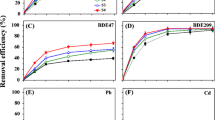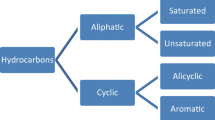Abstract
Polycyclic aromatic hydrocarbon (PAH) and metal-polluted sites caused by abandoned coking plants are receiving wide attention. To address the associated environmental concerns, innovative remediation technologies are urgently needed. This study was initiated to investigate the feasibility of a cleanup strategy that employed an initial phase, using methyl-β-cyclodextrin (MCD) solution to enhance ex situ soil washing for extracting PAHs and metals simultaneously, followed by the addition of PAH-degrading bacteria (Paracoccus sp. strain HPD-2) and supplemental nutrients to treat the residual soil-bound PAHs. Elevated temperature (50 °C) in combination with ultrasonication (35 kHz, 30 min) at 100 g MCD L−1 was effective in extracting PAHs and metals to assist soil washing; 93 % of total PAHs, 72 % of Cd, 78 % of Ni, 93 % of Zn, 84 % of Cr, and 68 % of Pb were removed from soil after three successive washing cycles. Treating the residual soil-bound PAHs for 20 weeks led to maximum biodegradation rates of 34, 45, 36, and 32 % of the remaining total PAHs, 3-ring PAHs, 4-ring PAHs, and 5(+6)-ring PAHs after washing procedure, respectively. Based on BIOLOG Ecoplate assay, the combined treatment at least partially restored microbiological functions in the contaminated soil. The ex situ cleanup strategy through MCD-enhanced soil washing followed by microbial augmentation can be effective in remediating PAH and metal-contaminated soil.




Similar content being viewed by others
References
Ahn CK, Kim YM, Woo SH, Park JM (2008) Soil washing using various nonionic surfactants and their recovery by selective adsorption with activated carbon. J Hazard Mater 154:153–160
Allan IJ, Semple KT, Hare R, Reid BJ (2006) Prediction of mono and polycyclic aromatic hydrocarbon degradation in spiked soils using cyclodextrin extraction. Environ Pollut 144:562–571
Allan IJ, Semple KT, Hare R, Reid BJ (2007) Cyclodextrin enhanced biodegradation of polycyclic aromatic hydrocarbons and phenols in contaminated soil slurries. Environ Sci Technol 41:5498–5504
Badr T, Hanna K, Brauer C (2004) Enhanced solubilization and removal of naphthalene and phenanthrene by cyclodextrins from two contaminated soils. J Hazard Mater 112:215–223
Chung HI, Kamon M (2005) Ultrasonically enhanced electrokinetic remediation for removal of Pb and phenanthrene in contaminated soils. Eng Geol 77:233–242
Dalgren KE, Arwidsson Z, Camdzija A, Sjöberg R, Ribé V, Waara S, Allard B, Kronhelm T, Hees PAW (2009) Laboratory and pilot scale soil washing of PAH and arsenic from a wood preservation site: changes in concentration and toxicity. J Hazard Mater 172:1033–1040
Ding J, Cong J, Zhou J, Gao SX (2008) Polycyclic aromatic hydrocarbon biodegradation and extracellular enzyme secretion in agitated and stationary cultures of Phanerochaete chrysosporium. J Environ Sci-China 20:88–93
Ehsan S, Prasher SO, Marshall WD (2007) Simultaneous mobilization of metals and polychlorinated biphenyl (PCB) compounds from soil with cyclodextrin and EDTA in admixture. Chemosphere 68:150–158
Epelde L, Mijangos I, Becerril JM, Garbisu C (2009) Soil microbial community as bioindicator of the recovery of soil functioning derived from metal phytoextraction with sorghum. Soil Biol Biochem 41:1788–1794
Fava F, Bertin L, Fedi S, Zannoni D (2003) Methyl-β-cyclodextrin-enhanced solubilization and aerobic biodegradation of polychlorinated biphenyls in two aged-contaminated soils. Biotech Bioeng 81:381–390
Garland JL (1996) Analytical approaches to the characterization of sample microbial communities using patterns of potential C source utilization. Soil Biol Biochem 28:213–221
Gong ZQ, Wang XG, Tu Y, Wu JB, Sun YF, Li P (2010) Polycyclic aromatic hydrocarbon removal from contaminated soils using fatty acid methyl esters. Chemosphere 79:138–143
Guo HQ, Liu ZY, Yang SG, Sun C (2009) The feasibility of enhanced soil washing of p-nitrochlorobenzene (pNCB) with SDBS/Tween80 mixed surfactants. J Hazard Mater 170:1236–1241
Hanna K, Brauer C, Germain P (2004) Cyclodextrin-enhanced solubilization of pentachlorophenol in water. J Environ Manage 71:1–8
Huguet MR, Marshall WD (2011) Scaling up a treatment to simultaneously remove persistent organic pollutants and heavy metals from contaminated soils. Chemosphere 83:668–673
Khodadoust AP, Reddy KR, Maturi K (2005) Effect of different extraction agents on metal and organic contaminant removal from a field soil. J Hazard Mater 117:15–24
Khodadoust AP, Omprasad N, Chandrasekaran S (2008) Cyclodextrin-enhanced extraction and removal of 2,4-dinitrotoluene from contaminated soils. Environ Eng Sci 25:615–626
Kim YU, Wang MC (2003) Effect of ultrasound on oil removal from soils. Ultrasonics 41:539–542
Kraaij R, Seinen W, Tolls J (2002) Direct evidence of sequestration in sediments affecting the bioavailability of hydrophobic organic chemicals to benthic deposit-feeders. Environ Sci Technol 36:3525–3529
Leppanen MT, Landrum PF, Kukkonen JVK (2003) Investigating the role of desorption on the bioavailability of sediment-associated 3,4,3′,4′,-tetrachlorobiphenyl in benthic invertebrates. Environ Toxicol Chem 22:2861–2871
Liu L, Wu LH, Li N, Luo YM, Li SL, Li Z, Han CL, Jiang YG, Christie P (2011) Rhizosphere concentrations of zinc and cadmium in a metal contaminated soil after repeated phytoextraction by sedum plumbizincicola. Int J Phytoremediat 13:750–764
Mao T, Hong SY, Show KY, Tay JH, Lee DJ (2004) A comparison of ultrasound treatment on primary and secondary sludges. Water Sci Technol 50:91–97
Mason TJ (2006) Sonochemistry and the environment—providing a “green” link between chemistry, physics and engineering. Ultrason Sonochem 14:476–483
Maturi K, Reddy KR (2008) Extractants for the removal of mixed contaminants from soils. Soil Sediment Contam 17:586–608
Mouton J, Mercier G, Drogui P, Blais JF (2009) Experimental assessment of an innovative process for simultaneous PAHs and Pb removal from polluted soils. Sci Total Environ 407:5402–5410
Ni JZ, Luo YM, Wei R, Li XH (2008) Distribution patterns of polycyclic aromatic hydrocarbons among different organic carbon fractions of polluted agricultural soils. Geoderma 146:277–282
Ni JZ, Luo YM, Wei R, Li XH (2010) Distribution of polycyclic aromatic hydrocarbons in particle-size separates and density fractions of typical agricultural soils in the Yangtze River Delta. Eur J Soil Sci 59:1020–1026
Pannu JK, Singh A, Ward OP (2004) Vegetable oil as a contaminated soil remediation amendment: application of peanut oil for extraction of polycyclic aromatic hydrocarbon from soil. Proc Biochem 39:1211–1216
Petitgirard A, Djehiche M, Persello J, Fievet P, Fatin RN (2009) PAH contaminated soil remediation by reusing an aqueous solution of cyclodextrins. Chemosphere 75:714–718
Semple KT, Doick KJ, Wick LY, Harms H (2007) Microbial interactions with organic contaminants in soil: definitions, processes and measurement. Environ Pollut 150:166–176
Shrestha RA, Pham TD, Sillanpää M (2009) Effect of ultrasound on removal of persistent organic pollutants (POPs) from different types of soils. J Hazard Mater 170:871–875
Simpson EH (1949) Measurement of diversity. Nature 163:668
Stroud JL, Tzima M, Paton GI, Semple KT (2009) Influence of hydroxypropyl-β-cyclodextrin on the biodegradation of 14C-phenanthrene and 14C-hexadecane in soil. Environ Pollut 157:2678–2683
Subramaniam K, Stepp C, Pignatello JJ, Smets BF, Grasso D (2004) Enhancement of polycyclic aromatic hydrocarbon desorption by complexing agents in weathered soil. Environ Eng Sci 21:515–523
Sun YY, Ji LL, Wang W, Wang XR, Wu JC, Li H, Guo HY (2009) Simultaneous removal of polycyclic aromatic hydrocarbons and copper from soils using ethyl lactate-amended EDDS solution. J Environ Qual 38:1591–1597
Sun MM, Fu DQ, Teng Y, Shen YY, Luo YM, Li ZG, Christie P (2011) In situ phytoremediation of PAH-contaminated soil by intercropping alfalfa (Medicago sativa L.) with tall fescue (Festuca arundinacea Schreb.) and associated soil microbial activity. J Soil Sediment 11:980–989
Talley JW, Ghosh U, Tucker SG, Furey JS, Luthy RG (2002) Particle-scale understanding of the bioavailability of PAHs in sediment. Environ Sci Technol 36:477–483
Teng Y, Luo YM, Ping LF, Zou DX, Li ZG, Christie P (2010a) Effects of soil amendment with different carbon sources and other factors on the bioremediation of an aged PAH-contaminated soil. Biodegradation 21:167–178
Teng Y, Luo YM, Sun MM, Liu ZJ, Li ZG, Christie P (2010b) Effect of bioaugmentation by Paracoccus sp. strain HPD-2 on the soil microbial community and removal of polycyclic aromatic hydrocarbons from an aged contaminated soil. Bioresour Technol 101:3437–3443
Wilcke W (2007) Global patterns of polycyclic aromatic hydrocarbons (PAHs) in soil. Geoderma 141:157–166
Yang Y, Zhang N, Xue M, Lu ST, Tao S (2011) Effects of soil organic matter on the development of the microbial polycyclic aromatic hydrocarbons (PAHs) degradation potentials. Environ Pollut 159:591–595
Yao HY, Xu JM, Huang CY (2003) Substrate utilization pattern, biomass and activity of microbial communities in a sequence of heavy metal-polluted paddy soils. Geoderma 115:139–148
Yin X, Han P, Lu XP, Wang Y (2004) A review on dewaterability of biosludge and ultrasound pretreatment. Ultrason Sonochem 11:337–348
Yu HS, Zhu LZ, Zhou WJ (2007) Enhanced desorption and biodegradation of phenanthrene in soil–water systems with the presence of anionic-nonionic mixed surfactants. J Hazard Mater 142:354–361
Zhou WJ, Zhu LZ (2007) Efficiency of surfactant-enhanced desorption for contaminated soils depending on the component characteristics of soil- surfactant–PAHs system. Environ Pollut 147:66–73
Acknowledgments
This work was supported by grants from the Natural Science Foundation of Jiangsu Province (Project BK2009016), the Chinese National Environmental Protection Special Funds for Scientific Research on Public Causes (Project 2010467016), and the Chinese National High Technology Research and Development Program (863 Program) (Project 2007AA061101).
Author information
Authors and Affiliations
Corresponding author
Additional information
Responsible editor: Robert Duran
Rights and permissions
About this article
Cite this article
Sun, M., Luo, Y., Teng, Y. et al. Remediation of polycyclic aromatic hydrocarbon and metal-contaminated soil by successive methyl-β-cyclodextrin-enhanced soil washing–microbial augmentation: a laboratory evaluation. Environ Sci Pollut Res 20, 976–986 (2013). https://doi.org/10.1007/s11356-012-1064-0
Received:
Accepted:
Published:
Issue Date:
DOI: https://doi.org/10.1007/s11356-012-1064-0




